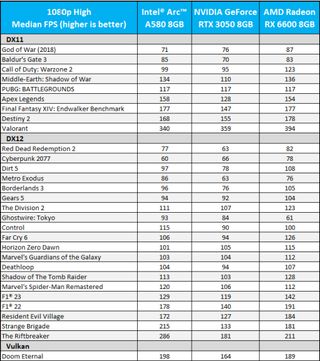Intel's Arc A580 is a new $179 budget graphics card that looks mostly D.O.A
Why bother with the A580 when you can pick up the bigger, better Arc A750 for $190?

If you thought Intel's Arc Alchemist lineup was be all sewn up by now, one year on from the release of the Arc A770 and Arc A750, surprise! Intel has a brand new budget graphics card: the Arc A580.
The Arc A580 sits in the middle of Intel's existing GPU stack; above the A380 that you definitely forgot about and below the A770 and A750. In terms of speeds and feeds, the A580 features the same G10 GPU as the two A7-series cards, though comes with fewer Xe-cores.
| Intel Arc A580 | Header Cell - Column 1 |
|---|---|
| SoC | ACM-G10 |
| Architecture | Xᵉ HPG |
| Render Slices | 6 |
| Xe-cores | 24 |
| Ray Tracing Units | 24 |
| Xe Vector Engines | 384 |
| Intel XMX AI Engines | 384 |
| Graphics Clock | 1.7GHz |
| Total Board Power (TBP) | 185W |
| Memory Size | 8GB |
| Memory Type | GDDR6 |
| Memory Interface | 256-bit |
| Memory Bandwidth | 512 GB/s |
| Memory Speed | 16 Gbps |
| PCI Express Interface | PCI Express 4.0 x16 |
| Lithography | TSMC N6 |
| Intel Adaptive Sync | Yes |
| Number of displays | 4 |
| H.264 Encode/Decode | Yes |
| H.265 Encode/Decode | Yes |
| AV1 Encode/Decode | Yes |
| VP9 Encode/Decode | Yes |
We're talking 24 Xe-cores, four fewer than the Arc A750. That also makes for 24 Ray Tracing Units, and yes, that does mean this sub-$200 card is able to accelerate ray tracing in-game. I probably wouldn't opt to turn many ray-traced effects on, however, the performance hit on a budget 1080p card like this is sure to be pretty significant.
The A580 comes with a noteworthy memory configuration for this price: 8GB of GDDR6 across a 256-bit memory bus. That's bandwidth of 512GB/s for a sub-$200 graphics card, matching the Arc A750, and raising the bar for budget graphics cards. Nvidia, eat your heart out.
Unfortunately, our review model is still yet to arrive, so I can't yet report our own performance figures. Intel has provided some benchmarks for this card for a rough idea, however. Make of them what you like.

As with all Intel Alchemist graphics cards, you can expect higher frame rates versus the competition when playing DX12 or Vulkan games—two up-to-date graphics APIs. On older APIs, like DX11, AMD's RX 6600 and Nvidia's RTX 3050 tend to pull a lead on the A580.
Though there's a big asterisk next to all of these figures: you need to be able to enable Resize BAR to get the most of this card, which is true of any Alchemist GPU.
PC Gamer Newsletter
Sign up to get the best content of the week, and great gaming deals, as picked by the editors.
Also note these are last-gen cards from the competition for comparison. Only AMD has an actually budget card out this generation, the RX 7600, and even then it's not really in the same price bracket as the A580. Though you could pick up the last-gen RX 6600 for around $210. Generally, though, the A580 is pretty competitively priced versus the competition, and you can't fault Intel for releasing a sub-$200 GPU in 2023.

Best CPU for gaming: The top chips from Intel and AMD.
Best gaming motherboard: The right boards.
Best graphics card: Your perfect pixel-pusher awaits.
Best SSD for gaming: Get into the game ahead of the rest.
It's not the competition that's the problem, however. Even a good price and decent memory configuration cannot stop the cannibalisation of Intel's latest GPU. The Arc A750, often discounted to around $200, is currently down to $190 right now, its lowest price yet. While that price may not last long, it is importantly available right now.
That's just $11 extra for the Arc A750, or $11 for four more Xe-cores to get down to brass tacks.
It's a tough one. You'd maybe be able to justify buying the A580 at around $150 or less, but instead it's rubbing shoulders with an Intel Arc graphics card that's had a whole year of discounts. Intel has taken such a long time to release this card, you do have to wonder what's caused such a delay getting it out. Unfortunately, at the price it's at today, and the price the A750 is at, it's tough to see the A580 as anything other than dead on arrival.

Jacob earned his first byline writing for his own tech blog. From there, he graduated to professionally breaking things as hardware writer at PCGamesN, and would go on to run the team as hardware editor. Since then he's joined PC Gamer's top staff as senior hardware editor, where he spends his days reporting on the latest developments in the technology and gaming industries and testing the newest PC components.
Most Popular







